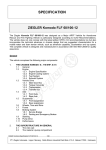Download ELAI user manual
Transcript
ELAI user manual
Yongtao Guan
Baylor College of Medicine
Version 1.0
25 June 2015
Contents
1 Copyright
2
2 What ELAI Can Do
2
3 A simple example
2
4 Input file formats
4.1 Genotype file format . . . . . . . . . . . . . . . . . . . . . . . . . . . . . . . . . . . .
4.2 Phased genotype file format . . . . . . . . . . . . . . . . . . . . . . . . . . . . . . . .
4.3 SNP position file format . . . . . . . . . . . . . . . . . . . . . . . . . . . . . . . . . .
3
3
3
4
5 Running ELAI
4
6 Output Files
6.1 Log file: prefix.log . . . . . . . . . . . . . . . . . . . . . . . . . . . . . . . . . . . .
6.2 SNP information file: prefix.snpinfo.txt . . . . . . . . . . . . . . . . . . . . . . .
6.3 Mean local ancestry dosage: prefix.ps21.txt . . . . . . . . . . . . . . . . . . . . .
5
5
6
6
7 Choice of parameters
7.1 Multiple EM runs. . . . . . . . . . . . . . . . . . . . . . . . . . . . . . . . . . . . . .
7.2 EM steps -s and a fast linear approximation -w. . . . . . . . . . . . . . . . . . . . .
6
6
6
8 Appendix A: ELAI Options
7
9 Appendix B: ELAI source code
7
1
1
Copyright
ELAI — Efficient local ancestry inference. Copyright (C) 2014–2015 Yongtao Guan.
This program is free software: you can redistribute it and/or modify
it under the terms of the GNU General Public License as published by
the Free Software Foundation, either version 3 of the License, or
(at your option) any later version.
This program is distributed in the hope that it will be useful,
but WITHOUT ANY WARRANTY; without even the implied warranty of
MERCHANTABILITY or FITNESS FOR A PARTICULAR PURPOSE.
See the GNU General Public License for more details.
You should have received a copy of the GNU General Public License
along with this program. If not, see http://www.gnu.org/licenses/.
2
What ELAI Can Do
The software, Efficient Local Ancestry Inference (ELAI), is developed and maintained by Yongtao Guan (http://www.ncbi.nlm.nih.gov/pubmed/24388880). Please refer to the paper for the
details of the statistical method. The ELAI is designed to perform local ancestry inference for admixed individuals. Comparing to existing methods to infer local ancestry, ELAI has the following
advantages:
• Directly works with diploid data, no phasing required,
• No recombination map is required—the recombination rates are implicitly estimated,
• It has a high resolution and can detect local ancestry track length of a few tenth of a centiMorgan (cM).
• The new version can process an arbitrary number of admixed samples (the previous version
requires splitting a large sample into small subsets).
3
A simple example
Untar the downloaded file, one finds a subfolder called ./example, and executables elai-mac for Mac
OS X and elai-lin for Linux. In the subfolder, those with suffix *.inp are input genotype files, the
one with suffix *.pos is the position file, and the other two files *.truth and *.marker contain truth
of the simulated admixture. A R-script, named r.2panel.R, is included to plot the example runs.
One may perform a testing run using the following command line:
./elai -g example/hap.ceu.chr22.inp -p 10 -g example/hap.yri.chr22.inp -p 11
-g example/admix-1cm.inp -p 1 -pos example/hgdp.chr22.pos
-s 20 -C 2 -c 10 -o test -mixgen 50 --exclude-nopos --exclude-miss1
This will generate four files with prefix ’test’ in a newly created subfolder ./output. Using the
R-script, r.2panel.R, one can plot the truth and the inferred local ancestries. Both the command
line for test run and a simple instruction to run the R script is in note.txt.
2
4
Input file formats
The users should prepare genotype files for admixed cohort samples and training samples from
source populations. All genotype files assume the BIMBAM format.
4.1
Genotype file format
Genotypes should be for bi-allelic SNPs, all on the same chromosome. The first two lines should
each contain a single number. The number on the first line indicates the number of individuals;
the number in the second line indicates the number of SNPs. Optionally, the third row can contain
individual identifiers for each individual whose genotypes are included: this line should begin
with the string IND, with subsequent strings indicating the identifier for each individual in turn.
Subsequent rows contain the genotype data for each SNP, with one row per SNP. In each row the
first column gives the SNPs “name” (which can be any string, but might typically be a rs-number),
and subsequent columns give the genotypes for each individual in turn. Genotypes must be coded
in ACGT while missing genotypes can be indicated by NN, ??, or 00 (zero). Example Genotype
file, with 5 individuals and 4 SNPs:
5
4
IND,
rs1,
rs2,
rs3,
rs4,
id1, id2, id3, id4, id5
AT, TT, ??, AT, AA
GG, CC, GG, CC, CG
CC, ??, ??, CG, GG
AC, CC, AA, AC, AA
Note that plink can convert genotype files from plink format to bimbam format. The option is
--recode-bimbam.
4.2
Phased genotype file format
By default ELAI assumes that the genotypes in the Genotype file are unphased. If one has data
where the phase information is known, or can be accurately estimated (e.g. from trio data, as in
the HapMap data), then this can be specified by putting an “=” sign at the end of the first line,
after the number of individuals. In this case, the order of the two alleles in each genotype becomes
significant: the first allele of each genotype should correspond to the alleles along one haplotype,
and the second allele of each genotype should correspond to the alleles along the other haplotype.
For example, in the following input file, the haplotypes of the first individual are AGCA and TCCC:
5 =
4
IND,
rs1,
rs2,
rs3,
rs4,
id1, id2, id3, id4, id5
AT, TT, ??, AT, AA
GC, CC, GG, CC, CG
CC, ??, ??, CG, GG
AC, CC, AA, AC, AA
3
Note: accidentally treating phased data as unphased has little harm except slower computation;
accidentally treating unphased panel as phased is very harmful. Please make sure the genotypes
are phased before you put “=” sign!
4.3
SNP position file format
The file contains three columns: the first column is the SNP ID, the second column is its physical
location, and the third column contains its chromosome number (optional). It is okay if the rows are
unordered, ELAI will sort the SNPs based on their position and chromosome number. ELAI can take
multiple position files as input, and duplicate entries are acceptable. If the genotype files contain
SNPs across different chromosome, ELAI will sort SNPs based on its chromosome and position.
However, we recommend users to run ELAI chromosome by chromosome. The following describes
an example file, where the delimit “,” can be changed to “ ”.
rs1, 1200,
rs2, 4000,
rs3, 3320,
1
1
1
In certain applications, one may insist on running multiple chromosomes together, then the
best practice is to stitch the position file together, and add 100, 000, 000 unto the SNP positions
with each chromosome swtich. For example, three lines in position file [rs11, 1200, 1], [rs22, 2323,
2], and [rs33, 3400, 4] may become [rs11, 1200, 99], [rs22, 100,002323, 99], and [rs33, 200,003400,
99]. The 100, 000, 000 increment is because ELAI used prior such that 100,000,000 corresponds to
1 Morgan.
5
Running ELAI
First some general comments:
• ELAI is a command line based program. The command should be typed in a terminal window,
in the directory in which ELAI executable exists.
• The command line should be all on one line: the line-break (denoted by back-slash) in the
example is only because the line is too long to fit the page.
• Unless otherwise stated, the “options” (-g -p -pos -o, etc.) are all case-sensitive.
• There are three key parameters to specify, number of upper clusters -C, number of lower
clusters -c, and number of admixing generations -mg.
Now we illustrate how to use ELAI through examples.
1. A minimal example for two-way admixture
./elai -g source_pop1.txt -p 10 -g source_pop2.txt -p 11 -g admixed_pop.txt \
-p 1 -pos position_file.txt -s 30 -o pref -C 2 -c 10 -mg 10
The command line will run EM 30 steps, uses 2 upper-layer clusters and 10 lower-layer
clusters, assuming number of admixture generation is 10. The output files will start with
“pref” in the output directory.
4
2. A more complicated example for three-way admixture
./elai -g source_pop1.txt -p 10 -g source_pop2.txt -p 11 -g source_pop3.txt \
-p 12 -g admixed_pop.txt -p 1 -pos position_file.txt -s 30 -o pref -C 3 \
-c 15 -mg 20 -exclude-maf 0.01 --exclude-miss 0.05 --exclude-miss1 \
--exclude-nopos
This command line takes three training samples of different ancestral source populations
(designated by -p 10, -p 11, and -p 12), and one admixed samples (designated by -p 1), merge
them based on the SNP position files. A SNP will be excluded by ELAI if its minor allele
frequency is < 0.01, or its missing proportion is > 0.05, or it is missed in one population, or
its position is not recorded in the position file. ELAI will fit a model of 3 upper clusters and
15 lower clusters, by running 30 EM steps. The output files will start with pref.
3. Use saved EM parameters.
./elai -g source_pop1.txt -p 10 -g source_pop2.txt -p 11 -g admixed_pop.txt \
-p 1 -pos position_file.txt -s 10 -o pref -C 2 -c 10 -mg 10 \
-rem output/pref.em.txt
This command line will read EM parameters saved in the first example (by default), and
continue to run 10 more steps.
4. The population label -p
ELAI assigns each individual an integer to designate its population label. The population
label can be 0, 1, 9, 10, 11, 12, . . .. The training samples are labelled as 10, 11, 12, . . ., with
each number represents an ancestry. It is important, however, that the labels for training
samples start with 10 and do not skip an integer. In other words, if the number of ancestral
populations is 2, then 10 and 11 will be used, neither 10 and 12, nor 11 and 12 is valid.
Similarly, if the number of ancestral populations is 3, then 10, 11, and 12 will be used. If
-p is followed by a valid integer, then all individuals in the matching genotype file will be
assigned a label of that integer. The -p can be followed by a filename; then that file must
contain the same number of entries as the number of individuals in the matching genotype
file, with one number occupying one row. Finally, an admixed cohort sample is labelled by
1, an un-labelled training sample is labelled by 0, and an sample that is to be excluded is
labelled by 9.
6
Output Files
ELAI produces output files in a directory named output/. The directory will be created automatically if it does not exist. The names of the output files begin with “prefix,” which can be specified
by the -o option. We now describe the contents of these output files.
6.1
Log file: prefix.log
A log file contains the command line, details of the progress, and warnings generated. When sending
in a bug report, it is important to include the log file as an attachment.
5
6.2
SNP information file: prefix.snpinfo.txt
This file contains 6 columns, with each SNP occupying a row. The columns are rsID, minor allele,
major allele, minor allele frequency, chromosome, and position.
6.3
Mean local ancestry dosage: prefix.ps21.txt
This file contains the estimated ancestral allele dosages for each individual at each SNP. This file
contains N lines, each admixed individuals occupies one line. Each line contains S × M entries,
where S is the number of source populations and M is the number of markers. Let j = S × k + s,
then j-th column of a row is the k-th SNP’s ancestry allele dosage of the s-th population. This file
has the same format for haploid and diploid individuals. In R, one may use the following commands
to scan and partition the ancestral allele dosages.
> yy=scan("output/prefix.ps21.txt");
> dim(yy)=c(S, M, N);
7
Choice of parameters
For the EM steps (specified with -s), a number between 20 and 50 is recommended. For the upper
layer number of clusters (specified with -C), please use 2 for African American, and 3 for Hispanics.
Other numbers is possible, provided that you have the appropriate panel data sets. But please
be careful with the interpretation. For the lower layer number of clusters (specified with -c), a
number, 5 × C is recommended. For the admixture generation (specified with -mg), please use 10
for African American, 20 for Hispanics, and 100 for Uyghurs. Other values of mixture generation
can be used, and the inferred local ancestry should be averaged.
7.1
Multiple EM runs.
By default, ELAI runs a single EM run. It is recommended to run ELAI multiple times and average
these results to achieve better estimates. It is important to use -R to specify a distinct random
number (seed) for each run. If -R is omitted ELAI will use the machine time as the random seed.
But when multiple jobs are run simultaneously, they may accidentally use the same random seed.
Thus, -R is highly recommended.
7.2
EM steps -s and a fast linear approximation -w.
The number of EM steps is specified by -s and -s 20 is recommended. This option fits the model
using a quadratic algorithm which is accurate but slow. We developed a fast linear approximation
to the quadratic algorithm, which is less accurate but fast. One may try it to get a quick glimpse
to the data, but it is not yet recommended for serious studies. The linear speed can be achieved
using -w 20 -s 0.
6
8
Appendix A: ELAI Options
Unless otherwise stated, arg stands for a string, num stands for a number.
File I/O related options:
• -g arg
can use multiple times, must pair with -p.
• -p arg
can use multiple times, must pair with -g. arg takes integer values, 1, 10, 11, 12, . . ..
• -pos arg
• -o arg
can use multiple times. arg is a file name.
arg will be the prefix of all output files, the random seed will be used by default.
EM Parameters:
• -s(step) num
specify steps in EM run.
• -C num
specify number of upper clusters.
• -c num
specify number of lower clusters.
• -mg num
specify number of mixture generations.
• -R num
specify random seed, system time by default.
• -sem num
save EM results to prefix.em.txt.
• -rem file
read EM from a file.
Other options:
• -v(ver)
print version and citation
• -h(help)
• -exclude-maf num
exclude SNPs whose maf is less than num , default 0.
• --exclude-nopos
exclude SNPs that has no position information
• --exclude-miss1
exclude SNPs that are missing in at least one file.
• --silence
9
print this help
no terminal output.
Appendix B: ELAI source code
If you want to compile an executable from the source code, the first thing to do is to install a gsl
library, which can be obtained from http://www.gnu.org/software/gsl/. Remember the path
to which the gsl is installed and modify the Makefile, the one in the src directory, substituting the
old path with the correct path. Then you may type make to compile.
7




















